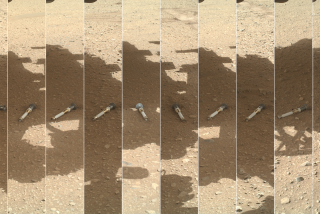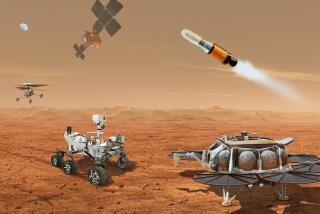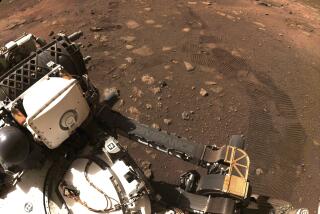OSIRIS-REx spacecraft reaches Bennu, and it will bring a piece of the asteroid back to Earth
NASA’s OSIRIS-REx mission to scoop up a piece of an asteroid and send it back to Earth is about to rendezvous with its target.
After a two-year journey through the solar system, the spacecraft has finally caught up with Bennu, a small, dark space rock that is orbiting the sun about 75 million miles from Earth.
On Monday, OSIRIS-REx — which stands for Origins, Spectral Interpretation, Resource Identification, Security-Regolith Explorer — will come within 13 miles of its new traveling companion.
Once the spacecraft arrives, mission controllers at the Lockheed Martin Space facility in Littleton, Colo., will begin to guide it even closer to the asteroid’s surface, where it will survey Bennu from a distance of just four miles.
NASA will livestream an event from the facility from 8:45 a.m. to 9:15 p.m. PST. You can watch it live here.

The first task for OSIRIS-REx will be to fly over Bennu’s north pole, equator and south pole and send images back to Earth. It will also start the initial search for a safe and scientifically interesting spot to grab some dirt and rocks from Bennu’s surface.
But these preliminary fly-bys are just the beginning. In the spring, the spacecraft will dive even closer to the asteroid to map its surface in unprecedented detail.
“All the design and development of the mission is based on what we thought Bennu would look like,” said Sandy Freund, OSIRIS-REx mission support area manager at Lockheed Martin Space. “Finally getting to see close-up images instead of making educated guesses is definitely exciting.”
Already, the spacecraft has sent back pictures of the asteroid from 85 miles away, revealing a lumpy, rocky surface.
OSIRIS-REx is outfitted with a suite of instruments to help it get better acquainted with Bennu. These include several cameras to examine the asteroid’s surface, a laser altimeter to map its topography, visible and infrared light spectrometers to reveal details of its chemical and mineral composition, and an X-ray spectrometer to study its elemental abundances.
Bennu is just 0.3 miles in diameter, and its gravity environment is 100,000 times weaker than what we experience here on Earth. All that makes it extremely difficult for OSIRIS-REx to land on its surface and scoop anything up.
Instead, the spacecraft is equipped with an 11-foot sampling arm that has three joints that function sort of like a shoulder, elbow and wrist. On the end of the arm is a round sampler head that looks similar to an air filter in a car.
After spending about 18 months in orbit around Bennu, OSIRIS-REx will fly close enough to the asteroid to give it a quick high-five with its sampler arm.
In the span of just five seconds, the sampler head will release a burst of nitrogen gas to stir up the material on Bennu’s surface and push some of the suspended particles through a filter into the sample head.
Once the material has been collected, the sampler head will spring off the asteroid and the robotic arm will deliver the sample to a container in the spacecraft. Mission planners call this the Touch-and-Go Sample Acquisition Mechanism, or TAGSAM.
The robot-arm-and-sample-head combo will have three chances to gather at least 2.1 ounces of Bennu’s surface dirt and dust, although it could gather much more — up to 4.4 pounds. This material will then be sent back to Earth, ultimately landing in the Utah desert in 2023.

Once the sample is returned, researchers will be able to study it for generations, just as the moon rocks brought back by the Apollo missions in the 1960s are still being analyzed today.
Scientists are particularly interested in studying material from dark, carbon-rich asteroids like Bennu because they could contain chemical compounds that seeded life on Earth.
Asteroids like Bennu might also have substantial amounts of water locked up in their minerals. If humans can learn how to extract hydrogen and oxygen from that water, perhaps it could be used to create rocket fuel in space. That could allow Bennu and other asteroids like it to serve as fueling stations for missions to Mars and beyond.
Pieces of asteroids occasionally fall to Earth as meteorites, and scientists do study those. However, it can be hard to tell which of their chemical properties they exhibited in space and which resulted from encounters with the effects of weather, organic life and other earthly forces that can alter the chemistry of a space rock.
OSIRS-REx is not the first asteroid sample return mission to launch from our planet. In 2010, Japan’s Hayabusa spacecraft brought back particles of the asteroid Itokawa despite technical difficulties during its rendezvous. A follow-up Japanese mission called Hayabusa2 is currently visiting the asteroid Ryugu, with plans to deliver a sample to Earth in late 2020.
Leaders of the OSIRIS-REx mission say their craft will be collecting a larger sample of material and doing it from the smallest planetary body ever orbited by a spacecraft.
“First-of-its-kind innovations like this one serve as the precursor for future missions to small bodies,” Freund said. “By proving out these technologies and techniques, we are going to be able to return the largest sample from space in half a century and pave the way for other missions.”
Twitter: @DeborahNetburn







